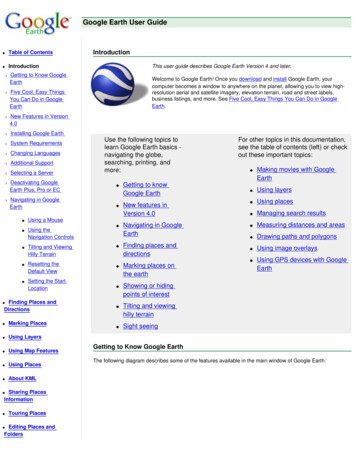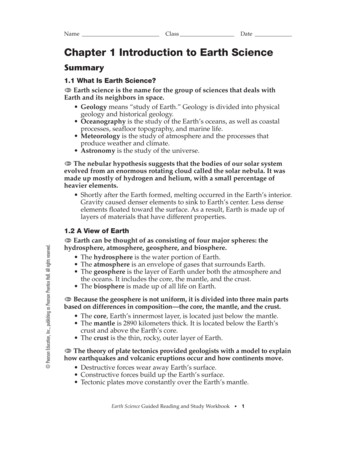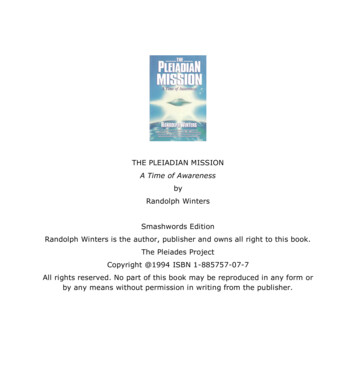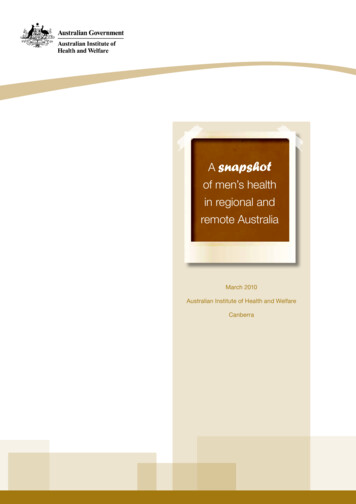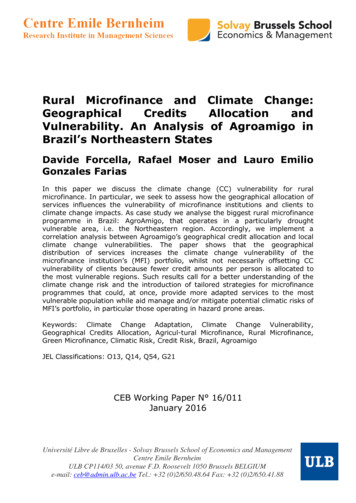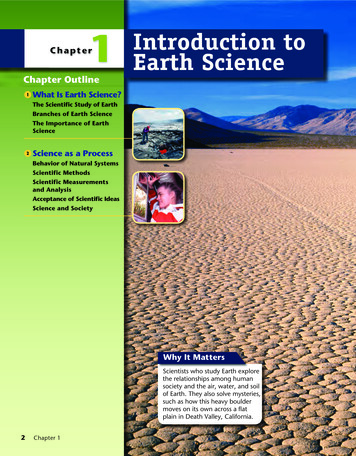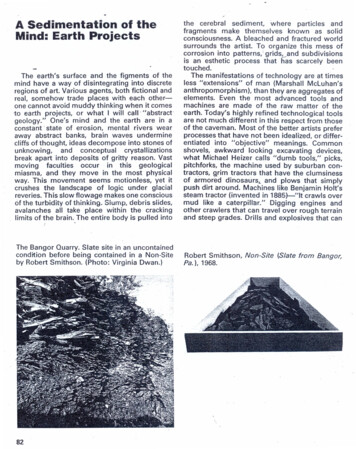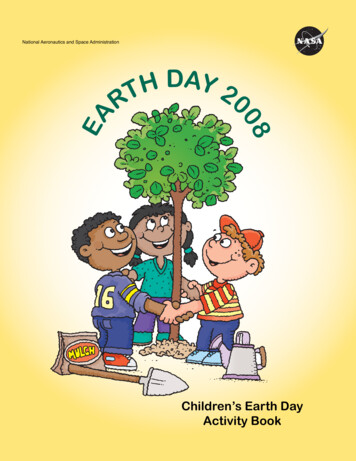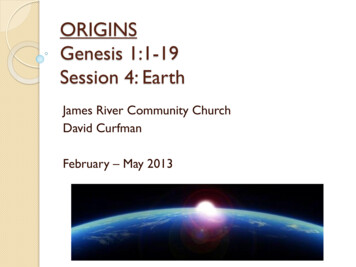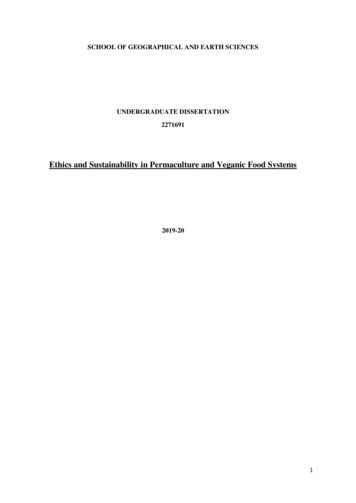
Transcription
SCHOOL OF GEOGRAPHICAL AND EARTH SCIENCESUNDERGRADUATE DISSERTATION2271691Ethics and Sustainability in Permaculture and Veganic Food Systems2019-201
University of GlasgowSchool of Geographical and Earth SciencesCOVER SHEET FOR DISSERTATIONDeclaration of OriginalityName: Samuel Thomas EcclesMatriculation Number: 2271691eCourse Name: Geography Level 4HTitle of Dissertation: Ethics and Sustainability in Permaculture and Veganic Food SystemsNumber of words: 9,997Plagiarism is defined as the submission or presentation of work, in any form, which is notone’s own, without acknowledgement of the sources. Plagiarism can also arise from onestudent copying another student’s work or from inappropriate collaboration. Theincorporation of material without formal and proper acknowledgement (even with nodeliberate intention to cheat) can constitute plagiarism. With regard to dissertations, the ruleis: if information or ideas are obtained from any source, that source must be acknowledgedaccording to the appropriate convention in that discipline; and any direct quotation must beplaced in quotation marks and the source cited immediately.Plagiarism is considered to be an act of fraudulence and an offence against Universitydiscipline. Alleged plagiarism will be investigated and dealt with appropriately by theSchool and, if necessary, by the University authorities.These statements are adapted from the University Plagiarism Statement (as reproduced inthe School Undergraduate Handbook). It is your responsibility to ensure that youunderstand what plagiarism means, and how to avoid it. Please do not hesitate to ask classtutors or other academic staff if you want more advice in this respect.Declaration: I am aware of the University’s policy on plagiarism and I certify that this pieceof work is my own, with all sources fully acknowledged.Signed: 2
AcknowledgementsI would first like to thank all of my interviewees for taking their valuable time to participatein this research and for everything I learned from my conversations with them. I am gratefulto my friends and sharing much needed breaks with them during long days at the library. Iwould also like to thank my two partners and my parents for being understanding andsupportive while I have been somewhat of a recluse in writing this dissertation up. Lastly, Iwould like to thank my supervisor Emma Cardwell for her feedback and enthusiasm for mytopic, it has been very encouraging.3
AbstractVeganism has been touted as a ‘silver-bullet’ solution to many of modern industrialagriculture’s devastating repercussions. Yet, current vegan food production retains some flaws,namely its reliance on environmentally harmful industrial farming methods and on animalinputs, thereby inadvertently supporting animal exploitation. This research project then, seeksto understand how vegan food production can become more sustainable by investigating twoalternative food systems: veganic farming and permaculture. In addition to analysing thecapacities and synergy of these two approaches to making vegan food production moresustainable, their ethical tensions were explored. Since permaculture is not inherently vegan,the movement’s philosophy towards animals conflicts with veganic farming and so it is worthexploring where these approaches differ and whether this can be reconciled. Finally, thescenario of Scotland adopting an entirely veganic permaculture food system was considered,highlighting the potential benefits, drawbacks and hinderances to this vision.4
ContentsChapter 1 - Introduction7Agriculture’s Detriments7Why Veganism?7Beyond Vegan Industrial Food Production8Permaculture: Potential Synergy with Veganism9Chapter 2 - Literature Review10Research Framework10A Vegan Perspective on the Ethics of Animal Agriculture11Criticisms of Veganic Food Production12Status of Permaculture14Scotland’s Agricultural Suitability17Research Niche19Chapter 3 - Methodology20Study Area20Data Collection20Documentary Analysis20Interviews22Data Processing23Positionality25Chapter 4 - The Value of Permaculture in Veganic Food Systems26Maintaining Soil Fertility26Pest Control27Yields and Scalability29Veganic-Permaculture in Marginal Lands30Chapter 5 - Permaculture and Domestic Animals: Progressive yet Incomplete32An Animal’s Purpose32The Treatment and Conditions of Animals33Attitudes of Permaculturists36Chapter 6 - Veganic Permaculture: A Food System for the Whole Geographic Community39A Veganic-Permaculture Imagining of Scotland30Barriers to this Imagining41Chapter 7 - ConclusionConcluding Remarks44445
Limitations and Opportunities for Further Research46Bibliography47Appendices52I - Coding Tallying52II - Interview & Documentary Analysis Coding Specimens53III - Yield Calculations for Scotland54IV - Logbook556
1 - IntroductionAgriculture’s DetrimentsModern agriculture is entangled within, and in some instances at the root of innumerable socioecological problems. Agriculture is heavily implicated in the climate breakdown, accountingfor 26% of anthropogenic GHG emissions. It requires substantial resources and occupies 43%of Earth’s ice- and desert-free land (Poore and Nemecek 2018). Agriculture’s growth hasextensively altered the distribution of global animal biomass, where humans and domesticanimals now considerably outweigh the biomass of all terrestrial vertebrates (Bar-On et al.,2018). Oceans are likewise suffering under our current food system. Predatory fish biomass is 10% of pre-industrial levels (Myers and Worm 2003), sharks are being killed faster than theycan re-populate (Worm et al., 2013) and agricultural runoff is causing oxygen depleted ‘deadzones’ to form near coastal areas (Breitburg et al., 2018). Wildlife is dwindling at such a ratethat a sixth mass extinction is now said to be in motion (Ceballos et al., 2015). Access tonutritious food is severely unequal with more than two billion people malnourished in someform, while there are even more people suffering from obesity (Weis and Weis 2007).Why Veganism?Veganism has been proposed as a seemingly straightforward and far-reaching strategy tomitigate or solve many of agriculture’s environmental issues. Animal agriculture requireshigher amounts of land and resources than growing plant foods. Poore and Nemecek (2018)estimate that 83% of global farmland is dedicated to animal agriculture yet it provides only18% of our calories. Globally, agriculture is already producing surplus calories to feed itspopulation a vegan diet (accounting for the expected population growth to 9.7 billion peoplein 2050) except that many human-edible crops are being fed to livestock (Berners-Lee et al.,2018). If Scotland phased out animal agriculture, 2,320 km2 of additional cropland could befreed to grow crops directly for humans. Pastureland could also be restored to native forests,sequestering an estimated 1,062 Mt of CO2, preventing further non-CO2 emissions fromlivestock, and improving the ecology (Harwatt and Hayek 2019). Shifting towards veganismcould alleviate pressure on marine species used as food, help avert the prospect of a postantibiotic era (Yao et al., 2016) and mitigate the spread of zoonotic diseases like avian7
influenza (Horby et al., 2014) which are linked with the squalor conditions of concentratedanimal feeding operations (CAFOs).Importantly, agriculture’s repercussions are suffered by human and non-human animalsalike. Veganism then, can not only make agriculture more sustainable but can emancipatefarmed animals and support wildlife.Despite the scepticism over a vegan diet’s nutritional adequacy, if it is well planned with afocus on the consumption of whole foods, it is a suitable diet for all stages of human life (Craigand Mangels 2009; Melina et al., 2016).Beyond Vegan Industrial Food ProductionDespite the significant potential benefits of a vegan food system, it is not without its own setof problems. There are worries that universal veganism would simply exacerbate industrialcrop production which can also cause extensive environmental devastation (Fairlie 2010;Milligan 2010). Tillage is on average eroding soils one to two orders of magnitude higher thansoil can be produced (Montgomery 2007). Monoculture food systems substantially reducebiodiversity and pollinator numbers (Varah et al., 2013). Pesticide and fertiliser use inintensive agriculture is linked to the rapid decline of insects, which if left unabated could leadto the extinction of 40% of Earth’s insect species in the coming decades (SánchezBayo and Wyckhuys 2019).Given that vegan food is produced with chemical fertilizers, pesticides and other detrimentalinputs, organic methods should then be considered a crucial component of an ecologicallyharmonious vegan food system. Importantly however, many organic inputs like manure andcompost are animal-derived and thereby inadvertently support the animal agricultureindustry (White 2018). Indeed, there is a misconception that animal manure and domesticanimals are a required component for organic farming (Milligan 2010). But this presumptionis being challenged by ‘veganic’ (vegan-organic) farming; an organic system which excludesall animal inputs apart from functions provided by free-living animals like wild bees (Schmutzand Foresi 2016). A move towards veganic farming as the new baseline in agriculture shouldthen be desired.8
Permaculture: Potential Synergy with VeganismYet, veganic farming is not without its critiques, both in terms of its technical ability andits underlying philosophy (Fairlie 2010). To address these critiques, I want to examineanother alternative approach to food systems called permaculture. Permaculture is anethical design framework that when applied to a food system could be described as themindful design of landscapes, mimicking ecosystem patterns and relationships in order tomeet human needs in a sustainable and regenerative way (Rhodes 2012). In researchingpermaculture, I want to assess its agricultural capabilities and how well it can respond tocritiques of veganic food production in the context of Scotland.While permaculture can be practised in conjunction with veganism, domestic animals andtheir inputs are still readily used in the movement. Using domestic animals in permaculturedoes not necessarily violate its ethical principles and the idea of excluding them based onprinciple is a controversial one (Rhodes 2012). For these reasons, I also want to investigatethe conditions of animals in permaculture and how permaculturists perceive the role ofanimals in their systems. In doing so, I hope to establish the tensions and synergies betweenveganism and permaculture’s ideal ethical relationship with non-human animalsLastly, I want to consider the scenario of a complete shift to veganic permaculture methodsin Scotland. How might this combination of veganic and permaculture ideas andvisions affect Scotland’s human and non-human inhabitants and its environment, and whatfactors obstruct this transition?With these aims in mind, my dissertation seeks to answer these three research questions:1.How does permaculture perform as a means of producing veganic food in Scotland?2.How inclusive is permaculture in its consideration of non-human animals in both itspractices and the attitudes of people involved in them?3.What would be the potential implications of Scotland adopting a veganicpermaculture mode of food production?9
2 - Literature ReviewResearch FrameworkBy grounding my research framework in veganism, I want to ensure this is not deployed ina biased ideological manner. I take inspiration from Jenkins, who conceptualizes veganismas a “necessary component” which for her sits within a larger “feminist ethics ofnonviolence” (2012:504). Veganism is not so much an identity as it is a tool which requireshoning. I too see veganism as a necessary component, but for the broader purpose ofenabling the optimal flourishing of the geographic community. This framing of veganismis built upon the coupling of two concepts: Lynn’s (1998) concept of geocentrism and thegeographic community, and Cuomo’s (2002) concept of an ethics of flourishing.The geographic community speaks to the entanglement of multiple human and non-humananimal communities who share the same geographic living space. In contrast toanthropocentrism, geocentrism extends the boundaries of the anthropocentric moralcommunity to encompass the geographic community. This displaces humanity asthe centre of moral value and instead establishes a plural centre of morality that values theindividual (human and non-human), species and ecosystemic components of thegeographic community all at once. In doing so it avoids overly emphasizing the moral valueof the individual or collective life-form.Flourishing is an ethical approach that is positively motivated in that it seeks to not merelyreduce suffering, but to let human and nonhuman life-forms thrive in the most optimalbalance possible. This approach attempts to avoid the excessive flourishing of one speciesat the expense of another. This concept also helps direct the use of veganism as a set ofactions we can take in the best interests of the geographic community. My analysis ofveganic and permaculture food systems then, seeks to establish how holistic these systemsare, how well does it meet the needs of the different members of the geographic community.10
A Vegan Perspective on the Ethics of Animal AgricultureIn discussing the ethics of keeping animals for food, focus will be turned to small-scalefarms as these are more pertinent to what permaculture food systems entail. Small-scaleanimal farming also raises more ethically contentious issues than say CAFOs, which makesit important to outline my vegan perspective on these points, in turn giving background tothe later analysis of permaculture.The kind of veganism being defined here is one that avoids all unnecessary harm toanimals, viewing unnecessary harm as unethical; what Abbate (2019b) termsthe Nonmaleficence Argument. Harm can be considered morally unnecessary, if thereare alternatives that cause less or no harm, or if the means do not justify the ends. Whendetermining whether some harm is morally necessary, it is crucial that this accounts for thegeographic community and not just human interests.Small-scale animal farming often justifies animal exploitation on the basis thatthe animals otherwise enjoy high standards of wellbeing throughout their lives. However,there are numerous problems with this justification. To contend that humanely killing ananimal is permissible because their life was pleasant misses the point that death is harmful,even when done painlessly, due to the fact its death was unnecessary (Abbate 2019b). Evenwhere animals may not be slaughtered, like keeping honeybees or hens, farming animalsrequires that they be controlled to some degree (Barnhill and Doggett 2018). Keepinganimals in controlled, enclosed spaces is a central way in which they are harmed (White2015), which Simmons (2016) argues, harms them through denying to a certain extent, theself-determined pursuit of their interests. Namely, their desire for mobility, to roam andexplore. The content of these spaces is similarly important and subtler harms like boredomor depression may arise by a lack of stimulation in the environment (Simmons2016). Wrenn (2013) argues the system itself is intrinsically problematic because theanimals’ commodity status results in their treatment as mere means.Ethics however, become blurred in circumstances where animal products can seemingly beharvested without harm. Fischer and Milburn (2019) argue that in the specific context thatyou have rescued a chicken from industrial farming (without the primary motive ofconsuming their eggs) and take good care of it, eating their unused eggs is not unethical.11
They acknowledge there may be morally preferable uses for these eggs but that no harm isnecessarily done in eating them. While this situation is perhaps too idealized, I would agreethat similar opportunities exist where consuming an animal product does not directly harmthe animal it came from. However, if we view this scenario through the ethical lens offlourishing, eating an egg is not helping us humans to flourish as they are not necessary forour health. Indeed, the geographic community could make better use of the egg. It could beleftto decompose, returning nutrientstothesoil, orbeeatenbyopportunistic wildlife or be purposely given to domestic animals that benefit nutritionallyfrom it (Donaldson and Kymlicka 2011). By the very fact that the egg has some better use,why would we not strive to choose this option? This reasoning likewise applies to why itspreferable not to consume other animal products even where it can be consumedharmlessly like roadkill (Abbate 2019a).Realistically though, food systems employ animals to fulfil some function. This function isnot always to produce food from their bodies. Animals may be used to prepare fieldsthrough fertilising it with their manure or turning the soil surface or controlling pests.Chickens are sometimes referred to as ‘tractors’ because of the extra services they provide(Machovina et al., 2015:428). Animals are chosen precisely for their utility tohumans. Consequently, animals who have no function to give (e.g. hens who stop layingeggs) are usually discarded or culled (Wrenn 2013). It remains to be seen how the treatmentof animals differs from the ‘humane’, small-scale farm as described, with permaculturebased food systems.In response to the harms imposed by animal agriculture, White calls for “empty cages, notlarger cages” (2015:26) for these animals. While I share this long-term goal, it must beacknowledged that even a gradual transition away from animal agriculture leaves us withthe question of what happens to the leftover animals? How and where will they live out therest of their lives? More research is crucial to answering these questions.Criticisms of Veganic Food ProductionHere I want to explore several criticisms launched against veganic farming so that I can thenfactor in how well it responds to these issues in my analysis.12
One critique is that crop production involves the collateral death of potentially larger numbersof animals (Lamey 2007). Machinery kills small mammals, fertiliser runoff and pesticidespoison fish, insects and birds, and animals in fields are more susceptible to predation (Fischerand Lamey 2018). This argument, however, failsto realise thedifferencebetweenunintentional and/or undesirable deaths caused in the necessary task of growing cropswith intentionaldeathscausedby unnecessary meatproduction(Jenkins2012).Nevertheless, Fischer and Lamey (2018) are right in that a serious effort should be taken toavoid field deaths in crop production. While this critique is less applicable to veganic farming,its pest control methods are still worthy of analysis.Veganism has also been criticised for placing more pressure on imported, and often luxuryfoods, thereby decreasing food security and increasing food miles (Fairlie 2010). Avocadoesare one such high-demand food that is impoverishing small-scale farmers in the Global South(Serrano and Brooks 2019). Furthermore, there is a tendency that the more plant-based esourced(Schmutzand Foresi 2016). Although dietary change reduces GHG emissions significantly more thaneating locally (Weber and Matthews 2008), relying less on imported foods is still worthwhile asfood security will become increasingly important in our warming climate.It has also been questioned whether vegan agriculture can be sustainable without animalderived manures and composts. Without the abundance of animal inputs, sustaining or buildingfertile soils could be difficult (Milligan 2010). In veganic systems, nitrogen is comfortablysupplied by green manures, but having sufficient phosphorous in the long-term is less secure(Fairlie 2010). If animals are not being used to bring in phosphorous from marginal lands,Fairlie contends that veganic food systems will need to recycle phosphorous-rich humanexcrement and urine to be sustainable.Veganic agriculture may also not be applicable to all geographic locations. For many peopleliving in marginal lands like mountains or islands, they may not be able to rely solely on cropsand need animals to consume vegetation inedible to humans so they can then obtain food fromthe animal (Milligan 2010). So, if people were to exclude animals, a local food source and thelivelihoods dependent on this would be lost.13
Status of PermaculturePermaculture, perhaps because of the limited scientific research into it, has been criticisedfor making unsubstantiated claims about its design principles, its ability to produce yields,its geographic applicability, and for downplaying the difficulties that come with buildingand maintaining such systems (Ferguson and Lovell 2014; Hathaway 2016). Yet, Krebs andBach (2018) have demonstrated that evidence exists for all twelve of permaculture’s designprinciples (Table 2.1). However, evidence for some principles is more substantial thanothers. The principle “Use edges and value the marginal” is supported by research showinghigher field edge densities is linked to increased biodiversity and marginal land attractsbeneficial pollinator and pest-predator species, reducing the need for pesticides (Krebs andBach). On the other hand, the principle “Obtain a yield” has more varied evidence and itseems the quantity of food produced is dependent on the site and the system’s design (Krebsand Bach).Table 2.1 – The left column lists permaculture’s 12 design principles originated by David Holmgren co-founder ofpermaculture and their description is quoted from Rhodes (2012:156). The right column lists examples of theimplementation of these principles as provided by Krebs and Bach (2018).Design Principle1. Observe and Interact - By taking the time toengage with nature we can design solutions that suitour particular situation.2. Catch and Store Energy - By developingsystems that collect resources when they areabundant, we can use them in times of need.3. Obtain a Yield - Ensure that you are getting trulyuseful rewards as part of the work that you are doing.4. Apply Self-Regulation andAccept Feedback - We need to discourageinappropriate activity to ensure that systems cancontinue to function well.5. Use and Value RenewableResources and Services - Make the best use ofnature's abundance to reduce our consumptivebehaviour and dependence on non-renewableresources.6. Produce no Waste - By valuing and making useof all the resources that are available to us, nothinggoes to waste.7. Design from Patterns to Details - By steppingback, we can observe patterns in nature and society.These can form the backbone of our designs, withthe details filled in as we go.8. Integrate Rather than Segregate - By puttingthe right things in the right place, relationshipsdevelop between those things and they worktogether to support each other.Examples with EvidenceAdaptive managementOrganic mulch applicationRainwater harvesting measuresWoody elements in agriculture‘Emergy’ evaluationEcosystem services conceptEnhancement of regulating ecosystem servicesNatural habitats in agricultural landscapesWildflower stripsLegumes and animal manure as nutrient sourceMycorrhizal fungiAnimal manureHuman excretaWaste products as animal feedNatural ecosystem mimicryUse of grazing animals in cold and dry climatesStructurally complex agroforests in tropicalclimatesIntegration of livestock in corn croppingCereals and canola used for forage and grain harvestIntegration of fish in rice croppingPolyculture (crops)14
9. Use Small and Slow Solutions - Small and slowsystems are easier to maintain than big ones, makingbetter use of local resources and producing moresustainable outcomes.10. Use and Value Diversity - Diversity reducesvulnerability to a variety of threats and takesadvantage of the unique nature of the environment inwhich it resides.11. Use Edges and Value theMarginal - The interface between things is wherethe most interesting events take place. These areoften the most valuable, diverse and productiveelements in the system.12. Creatively Use and Respond toChange - We can have a positive impact oninevitable change by carefully observing, and thenintervening at the right time.Inverse productivity-size relationshipAgroforestry systemsPlant species diversityPollinator diversityHabitat diversityDiversified farming systemsHigh field border densityField marginsEdges with forestsDecision-making under uncertaintyIncrease ecological resilienceDirected natural successionWhile there is a scarcity of research on permaculture and much of this focuses on tropicallatitudes, there are several studies relevant to permaculture food systems in temperateclimates. Nytofte and Henriksen (2019) measured the average annual yield of a 0.08 hapermaculture food forest in the Scottish borders. They extrapolated these results to an areaof one hectare, suggesting similar food forests could provide enough carbohydrates, fat andprotein for 7, 4 and 3 males and 9, 5 and 4 females respectively. They also cite a yet to bepublished study by Lavoll et al. (2019) who found that a temperate food forest couldproduce enough food calories for ten people per hectare. More generally, Morel et al.(2018)foundthat permaculturefarmsfocusing onlyon food production, werevery variable in terms of their production levels, inputs, labour and income, echoing Krebsand Bach’s (2018) findings on permaculture yields. This range of variability though iscomparable to farms that employ organic, low-input and agroecological methods (Morel etal., 2018). Permaculture food systems are potentially economically viable too as Morel etal. (2015) found that a permaculture-based market garden in France could make a monthlyincomeof 898-1,571 onanaverageof43workhoursperweek withoutmechanisation. Fittingly, Fairlie performed some rudimentary calculations testing whetherthe UK could feed itself using veganic permaculture; where permaculture was taken tomean the large-scale “integration of lifestyle with natural and renewable cycles”(2010:100). Remarkably, the UK could theoretically meet its food needs using thisapproach, feeding 8 people per hectare on average and leaving 11.2 million hectares of landfor non-food uses.15
Permaculture’s emphasis on designing food systems for sustainability often means theinclusion of perennial crops, especially trees is encouraged. In temperate climates, alleycropping (a simpler design of a permaculture food forest) is the most intensive way ofintegrating treeswithannualcrops whilststillretaining highproductivity.By growing annual crops between rows of trees, alley cropping over-yields, meaning itproduces more food overall than growing tree and annual crops separately (Wilson andLovell 2016; Wolz et al. 2018). In addition, alley cropping has several otherbenefits including climate change mitigation and resilience, better labour and marketstability, energy production, and they can be suitable for marginal lands (Wilson and Lovell2016; Wolz et al., 2018). Although Rhodes (2012) notes that if agriculture was morealigned with permaculture and integrated more perennial species, grain yields will be muchlower than current industrial-scale outputs. Our diets would then need to consist of largerproportions of other plant-based food groups.Notably, some research indicates permaculture is well suited to fostering deeper ecologicalconsiderationandpracticalengagement amongstitspractitioners (Hathaway2016). Millner (2016) finds that there is a striving in permaculture to support human andnon-humans through the establishment of ‘permanent cultures’ which act as multi-speciesecologies. In addition, Puig de la Bellacasa argues that in doing permaculture, we developan awareness of our interdependency with all the non-human beings in the system. So nolonger do we perceive animals as “there to serve ‘us’. [But rather] They are here to livewith” (emphasis added, 2010:161). In this regard, the doing of permaculture and sharingour immediate space with animal others could counter anthropocentric attitudes (Puig dela Bellacasa 2010) which may then lend consideration towards veganism. However, inreading permaculture’s ethical principles (Table 2.2), the implicit reference to animals aspart of the wider ecosystem has tones of ecocentrism (Lynn 1998) and certain aspects ofthe principles are open for personal interpretation.Table 2.2 – Lefthand column lists permaculture’s 3 ethical principles and the righthand column describes how they areimplemented. Adapted from Rhodes (2012)Ethical PrincipleEarth CareExplanationEnsuring all life systems can continue and multiply. Involves: Working with nature Opposing destruction and damage Making considerate choices Making minimal environmental impact Meeting our needs by designing healthy systems16
People CareEnsuring people can access those resources they need to live. Involves: Caring for oneself and others Cooperating Helping those unable to access life’s necessities Lead low impact lifestyles Designing systems to be sustainableBy meeting our own needs and living lightly, surplus resources can be used tofurther the other principles. Involves: Restricting our consumption so there is enough for all at present andin the future Creating economic ‘lifeboats’ Establishing common unity Changing our lifestyle now and not waiting Reconnecting with nature to shift our thinking and being.Fair ShareScotland’s Agricultural SuitabilityUnderstanding Scotland’s biogeographic conditions is vital in connecting generalisedagricultural knowledge from the veganic and permaculture movements, to specificlocalities. Table 2.3 outlines Scotland’s different classes of agricultural land and Figure2.1 shows the distribution of these classes.Table 2
Since permaculture is not inherently vegan, the movement’s philosophy towards animals conflicts with veganic farming and so it is worth exploring where these approaches differ and whether this can be reconciled. Finally, the scenario of Scotland adopting an
